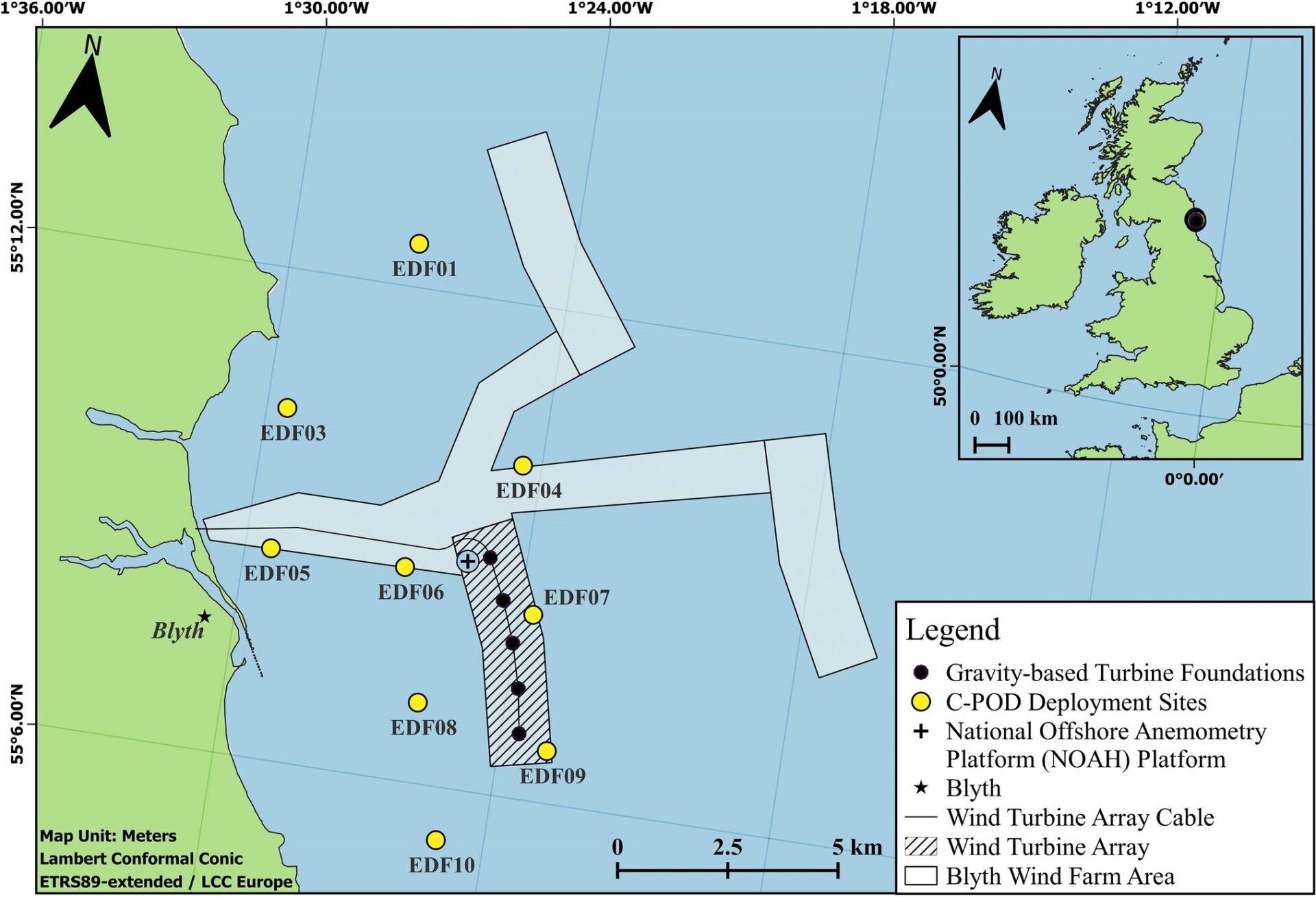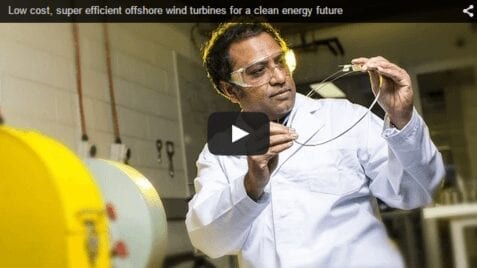
The deployment locations of the nine cetacean echolocation recorders (C-PODs) used to monitor occurrence of dolphins and harbour porpoise during the development of EDF Renewables’ Blyth Offshore Demonstrator wind turbine array off Northumberland, United Kingdom.
Credit: Marine Biology (2023). DOI: 10.1007/s00227-023-04240-1
Gravity-base structures may offer a porpoise and dolphin-friendly construction alternative to traditional pile-driven wind turbine foundations, new research suggests.
Marine scientists from Newcastle University investigated short- and long-term impacts of this new wind turbine installation method on cetaceans off Blyth, Northumberland. The response of dolphins and harbour porpoises was investigated using cetacean echolocation recorders over a three-year period, covering one year before, during and after the installation.
The findings revealed that wind turbine installation using gravity-base foundations had no long-term effects on the occurrence of dolphins or porpoises.
“Our findings are important in light of the global expansion of offshore wind farms and the need to find installation methods that have less impact to the marine environment”, says lead author and master’s graduate Kelsey Potlock. “These findings are promising for conservationists, marine environmental managers, and for the future of offshore renewable energy.”
Published in the journal Marine Biology, the results show that the installation of wind turbines using gravity-base foundations had no long-term negative effects on dolphin presence, while porpoise occurrence increased by 32% and 75% during and after the construction phase, respectively, when compared to the pre-construction period. Other factors, such as month, hour of the day, tidal currents, and vessel sonar activity were found to influence the presence of dolphins and porpoises off Blyth.
Impact of wind developments on species and ecosystems
Offshore wind developments may cause physical and acoustic disturbance to marine ecosystems and species. Toothed whales like dolphins and porpoises use high-frequency echolocation signals to navigate their surroundings and locate prey and the noise generated by offshore construction activities can mask these signals, making it challenging for whales to accurately perceive their environment and find food.
Gravity-based foundations are large concrete structures that sit on the seabed and rely on their weight to provide stability for the wind turbine. They consist of a concrete base into which the shaft of the wind turbine is installed. They offer an alternative to traditional pile-driven installations, with less underwater noise and physical disturbance.
The study’s senior author, Professor Per Berggren, Chair of Marine Megafauna Conservation at Newcastle University’s School of Natural and Environmental Sciences, said:
“Installation of wind turbines using gravity-base foundations could provide a more sustainable construction method for offshore wind developments. While the results are incredibly promising, we did observe a temporary decrease in dolphin occurrence during the construction phase, as well as a change in the daily activity patterns of harbour porpoises during and after construction, indicating a need for further investigation.”
Original Article: Gravity foundations: A marine-friendly future for wind turbines
More from: Newcastle University
The Latest Updates from Bing News
Go deeper with Bing News on:
Wind turbine foundations
- Wind Energy News
Apr. 17, 2024 — Wind power is a source of energy ... fuel -- with green hydrogen could provide the foundation for wider deployment of renewable energy, such as solar ... What Will It Take ...
- New Cranes & Offshore Wind Efficiency
The end may be in sight, but the race for bigger cranes is still having an impact on offshore wind project efficiency.The ...
- Guest Column: Energy expertise and innovation leadership make Louisiana a global offshore wind force
This week, thousands of professionals attended Oceantic Network’s International Partnering Forum in New Orleans, one of the largest offshore wind industry conferences. While harnessing wind energy at ...
- BW Ideol Presents Standard Floating Wind Foundation for Mass Production
BW Ideol has unveiled its standardized floating foundation product for floating offshore wind, ready for mass production to ...
- One of Europe’s Fastest-Growing Energy Companies Wants a Slice of the U.S. Offshore Wind Market
Octopus Energy plans to invest between $10 million and $30 million in California-based Ocergy, a producer of floating offshore wind turbines.
Go deeper with Bing News on:
Gravity-base foundations
- Gravity Ohio to host members of Cameron Mitchell Restaurants team
Gravity Ohio founder Dan Lew and NCSC are examining how area students can enhance their education and prepare them for culinary entrepreneurship.
- Exclusive: $25 million lead gift from Mays Family Foundation will fund Texas A&M graduate building
Mays Family Foundation lead gift of $25 million will fund Mays Business School Education Complex new graduate building at Texas A&M University College Station ...
- Private Foundations Made Artists and Dealers Rich. What If Many Are Just ‘Tools for Flippers’?
“Every gallery says, ‘We sell to institutions and foundations, and we have two paintings we can sell to collectors,’ ” one New York-based collector and advisor told me. “I don’t understand why I can’t ...
- Navy veteran in Lebanon receives accessible home through Gary Sinise Foundation
The foundation welcomed retired U.S. Navy Petty Officer First Class John Kremer and his family to their new home in Lebanon.
- Owlstone gets $6.5M from Gates Foundation for breath-based diagnostics
Owlstone Medical Ltd. received $6.5 million in funding from the Bill & Melinda Gates Foundation which will go towards expanding its Breath Biopsy platform as well as developing breath-based diagnostic ...










